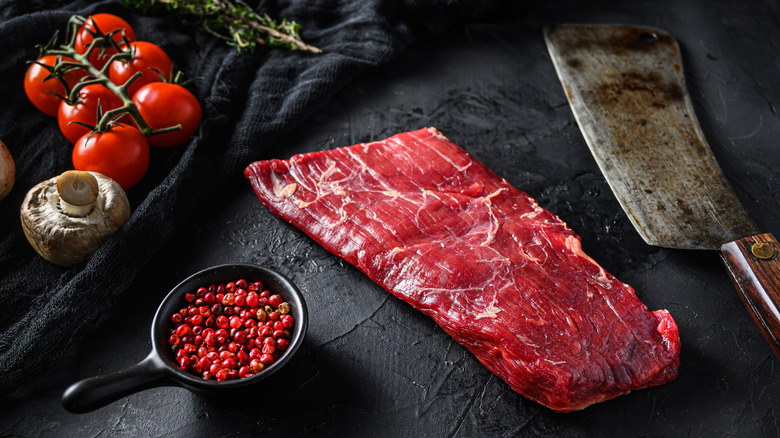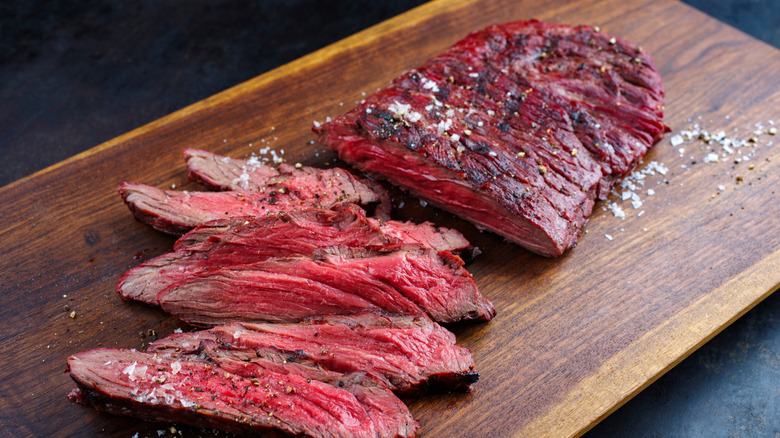The Best Way To Cook Bavette Steak For Juicy, Tender Results
Cooking steaks at home can be a little tricky, especially if you're unfamiliar with the cut or not doing it on a regular basis. But if you follow the right advice, you can get them amazingly tender, juicy, and cooked just right every time. Martha Stewart's method for the perfect porterhouse will ensure you get a thick, caramelized crust — the trick is in the broiler. For a restaurant-quality ribeye at home, following some easily workable tips will provide the perfect sear and temperature. But when it comes to less common cuts, like the bavette steak, (often called flap steak in United States grocery stores), the advice can be a little bit harder to come by because it's not quite as popular in North America.
So we decided to go right to the pros and reached out to a bavette expert, Kevin Chrisman, executive chef at Golden Hour (@goldenhouravl on Instagram) in Asheville, North Carolina. "The absolute best way to cook bavette steak is over wood with a very high heat," says Chrisman, "and then transferring to a warmer area to 'rest.'"
To the unfamiliar, a bavette cut, named after the French word for "bib" (because it's shaped like a baby's bib), comes from the sirloin part of the cow, near the lower belly. Bavette is a well-loved cut in France, where it appears on many a bistro table. This cut is prized for its deep, beefy flavor and good marbling. Because it has a looser grain, bavette can be on the tough side (rather than a satisfying tender chewiness) if you don't get it right, so it's best to follow Chrisman's advice.
How to get a tender, juicy bavette steak with a beautiful crust
Bavette is a relatively thin cut, so it's good to cook it hot and fast to seal in flavor and make a quick crust. Plus, the loose grain can hold up to high heat. Golden Hour specializes in wood-fired cooking, so it's no surprise that Kevin Chrisman would recommend cooking over wood. But a wood-fired grill is an excellent way to get a super hot sear on the side facing the flame without overcooking it on all sides or internally. Cooking over hot coals or in a skillet can also help get a decent crust and seal in moisture, but nothing beats the added smoky flavor of cooking over wood.
Since Chrisman recommends letting the bavette rest in a warm spot, you may want to set it somewhere near the flame after searing on both sides, as long as it's cool enough to prevent further cooking. In French bistros, bavette is often served topped with caramelized shallots (bavette à l'échalote) that complement the unctuous, juicy flavor. These are easy to make if you slice them thin and sauté them (not too hot) in olive oil, finishing with red wine vinegar and butter. Bavette lends itself well to sauces, like a rich and flavorful mushroom steak sauce. It's similar to a skirt steak, and works great in a simple steak frites combo, as well.
As for the correct temperature on a bavette, Chrisman likes it beyond medium-rare. "I like a nice medium cooked bavette," he says. "This ensures that all of the fat can be cooked through while remaining tender." And if you're new to bavette, does Chrisman think you'll need to do anything else differently on the cook? "No, not necessarily," he says. "I think when you're cooking meat, you should stick to your guns and with what you know and like."

